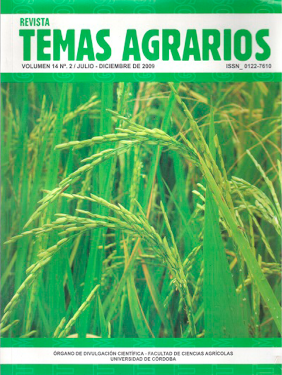Extraction and caracterized of yam starch and development antimicrobian edibles films
Extração e Caracterização do Amido de Inhame e Desenvolvimento de Filmes Comestíveis Antimicrobianos
How to Cite
Durango Villadiego, A. M., Soarez, N., & Andrade, N. (2009). Extraction and caracterized of yam starch and development antimicrobian edibles films. Sour Topics, 14(2), 33-42. https://doi.org/10.21897/rta.v14i2.672
Dimensions
license

This work is licensed under a Creative Commons Attribution-NonCommercial 4.0 International License.
Show authors biography
Article visits 1478 | PDF visits
Downloads
Download data is not yet available.
- Abramo, M. 1990. Taioba, cará e inhame: o grande potencial inexplorado. Ícone, São Paulo, 80 p.
- Alves, R., Grossmann, M. y Silva, R. 1999. Gelling properties of extruded yam (Dioscorea alata) starch. Food Chemistry 67:123-127.
- AACC (American Association of Cereal Chemists). 1982. Approved Methods of the AACC. St. Paul, AACC, p22-10.
- ASTM (American Society for testing and materials). 1995. Standards test methods for water vapor tansmission of materials - E - 95. ASTM, Philadelphia, 8p.
- Anuário a granja do ano. 1994. Cará e Inhame. Centaurus, São Paulo, p30-35.AOAC (Association of Official Analytical Chemistry). 1995. Official
- Methods of Analysis. 16th ed. Arlington, TX: Association of official Analytical Chemistry. Vol. 2.
- Arvanitoyannis, I.; Nakayama, A. y Aiba, S. 1998. Edible films made from hydroxypropyl starch and gelatin and plasticized by polyols and water. Carbohydrate Polymers 36:105-119.
- Cereda, M. 2001. Culturas de Tuberosas Amilâceas Latino Americanas. Cargill, São Paulo, Vol. 2. p511-518.
- Ciacco, C. y Cruz, R. 1982. Fabricação de amido e sua utilização. Série Tecnologia Agroindustrial, Secretaria de Indústria, Comércio, Ciência e Tecnologia, São Paulo, 152p.
- Cruz, R. y EL Dash, A. A. 1984. Isolamento e caracterização de amido de chuchu. Revista Ceres 31(175):173-188.
- Daiúto, E. y Cereda, M. 2003. Extração de fécula inhame (Dioscorea sp). En: Cereda, M. y Vilpoux, O. (Eds). Culturas de Tuberosas Amilâceas Latino Americanas. Cargill, São Paulo, p177-190.
- Emiola, L. y Delarosa, L. 1981. Physicochemical characteristics of yam starches. Journal of Food Biochemistry 5:115-130.
- García, M., Martino, M. y Zaritzky N. 1999. Edible starch Films and coatings characterization: scanning electron microscopy, water vapor, and gas permeabilities. Scanning 21(5):348-353.
- García, M., Martino, M. y Zaritzky N. 2000. Lipid addition to improve barrier properties of edible starch-based films and coatings. Journal of Food Science 65(6):941-947.
- Gennadios, A. y Weller, C. 1990. Edible films and coatings from wheat and corn proteins. Food Technology 44(10):63-69.
- Gontard, N., Guilbert, S., y Cuq, B. 1992. Edible wheat gluten films: influence of the main process variables on film properties using response surface methodology. Journal of Food Science 57(1):190-195.
- Guilbert, S., Gontard, N. y Gorris G. 1996. Prolongation of the shelf-life of perishable food products using biodegradable films and coatings. Lebensmittel- Wissenschoft und- Technologie 29(1-2):10-17.
- Hagenmaier, R. y Shaw, P. 1990. Moisture permeability of edible films made with fatty acid and hydroxypropyl methylcellulose. Journal of Agriculture Food Chemistry 38:1799-1803.
- Klahorst, S. 1999. Applications: Credible Edible Films. Food Product Design 9(1):1-6.
- Krochta, J. y Demulder-Johnston C. 1997. Edible and biodegradable polymer films: challengers and opportunities. Food Technology 51(2):61-74.
- Lawton, J. 1996. Effect of starch type on the properties of starch containing films. Carbohydrate Polymers 29:203-208.
- Lehninger, A.; Nelson, D. y Cox, M. 1995. Princípios de Bioquímica. Sarvier, São Paulo, 839 p.
- Leonel, M.; Cereda, M. 2002. Caracterização físico-química de algumas tuberosas amiláceas. Ciência e Tecnologia de Alimentos 22(1).
- Mali, S.; Grossmann, M.; García, M.; Martino, M. y Zaritzky N. 2002. Microstructural characterization of yam starch films. Carbohydrate Polymers 50:379-386.
- Mali, S.; Grossmann, M.; García, M.; Martino, M. y Zaritzky N. 2004. Barrier, mechanical and optical properties of plasticized yam starch films. Carbohydrate Polymers 56(2):129-135.
- Mchugh, T.; Avena-Bustillos, R. y Krochta, J. 1993. Hydrophilic edible films: modified procedure for water vapor permeability and explanation of thickness effects. Journal of Food Science 58(4):899-903.
- Mchugh, T. y Krochta, J. 1994. Permeability Properties of Edible Films. En: Krotcha, J.; Baldwin, E. y Nisperos-Carriedo, M. (Ed). Edible Coatings and Films to Improve Food Quality. Technomic, Pennsylvania, 379 p.
- Mchugh, T.; Huxsoll, C. y Krochta, J. 1996. Permeability properties of fruit puree edible films. Journal of Food Science 61(1):88-91.
- Omonigho, S. y Ikenebomeh, M. 2000. Effects of different preservative treatments on the chemical changes of pounded white yam (Dioscorea rotundata) in storage at 28 ± 2 ºC. Food Chemistry 68:201-209.
- Park, H. y Chinnan, M. 1995. Gas and water vapor barrier of edible films from protein and cellulose materials. Journal of Food Engineering 25:497-507.
- Petersen, K.; Nielsen, P.; Bertelsen, G.; Lawther, M.; Olsen, M.; Nilsson, N. y Mortensen, G. 1999. Potential of biobased materials for food packaging. Food Science and Technology, 10:52-68.
- Santos, E. 1996. Inhame (Dioscorea spp.): aspectos básicos da cultura. EMEPA-PB, SEBRAE, João Pessoa, 158p.
- Schoch, T. 1964. Swelling power and solubility of granular starches. En: Whistler, R. y Wolfrom, M. (Ed). Methods in Carbohydrates Chemistry, Academic Press, New York, p106 – 108.
- Schoch, T. y Leach, H. 1964. Determination of Absolute Density. Liquid Displacement. En: Whistler, R. y Wolfrom, M. (Ed). Methods in Carbohydrates Chemistry, Academic Press, New York, p101–103.




















